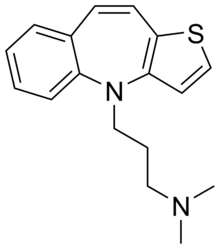
Tricyclic antidepressants (TCAs) are a class of medications that are used primarily as antidepressants, which is important for the management of depression. They are second-line drugs next to SSRIs. TCAs were discovered in the early 1950s and were marketed later in the decade. They are named after their chemical structure, which contains three rings of atoms. Tetracyclic antidepressants (TeCAs), which contain four rings of atoms, are a closely related group of antidepressant compounds.

Tetracyclic antidepressants (TeCAs) are a class of antidepressants that were first introduced in the 1970s. They are named after their tetracyclic chemical structure, containing four rings of atoms, and are closely related to the tricyclic antidepressants (TCAs), which contain three rings of atoms.

Maprotiline, sold under the brand name Ludiomil among others, is a tetracyclic antidepressant (TeCA) that is used in the treatment of depression. It may alternatively be classified as a tricyclic antidepressant (TCA), specifically a secondary amine. In terms of its chemistry and pharmacology, maprotiline is closely related to other secondary amine TCAs like nortriptyline and protriptyline, and has similar effects to them.

Dosulepin, also known as dothiepin and sold under the brand name Prothiaden among others, is a tricyclic antidepressant (TCA) which is used in the treatment of depression. Dosulepin was once the most frequently prescribed antidepressant in the United Kingdom, but it is no longer widely used due to its relatively high toxicity in overdose without therapeutic advantages over other TCAs. It acts as a serotonin–norepinephrine reuptake inhibitor (SNRI) and also has other activities including antihistamine, antiadrenergic, antiserotonergic, anticholinergic, and sodium channel-blocking effects.

Butriptyline, sold under the brand name Evadyne among others, is a tricyclic antidepressant (TCA) that has been used in the United Kingdom and several other European countries for the treatment of depression but appears to no longer be marketed. Along with trimipramine, iprindole, and amoxapine, it has been described as an "atypical" or "second-generation" TCA due to its relatively late introduction and atypical pharmacology. It was very little-used compared to other TCAs, with the number of prescriptions dispensed only in the thousands.

Iprindole, sold under the brand names Prondol, Galatur, and Tertran, is an atypical tricyclic antidepressant (TCA) that has been used in the United Kingdom and Ireland for the treatment of depression but appears to no longer be marketed. It was developed by Wyeth and was marketed in 1967. The drug has been described by some as the first "second-generation" antidepressant to be introduced. However, it was very little-used compared to other TCAs, with the number of prescriptions dispensed only in the thousands.

Tricyclics are chemical compounds that contain three interconnected rings of atoms.
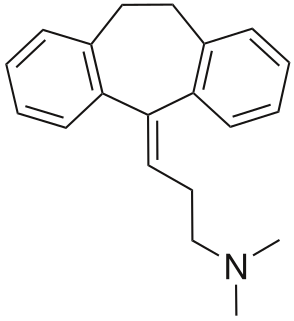
Tricyclic antidepressant overdose is poisoning caused by excessive medication of the tricyclic antidepressant (TCA) type. Symptoms may include elevated body temperature, blurred vision, dilated pupils, sleepiness, confusion, seizures, rapid heart rate, and cardiac arrest. If symptoms have not occurred within six hours of exposure they are unlikely to occur.

Prothipendyl, also known as azaphenothiazine or phrenotropin, is an anxiolytic, antiemetic, and antihistamine of the azaphenothiazine group which is marketed in Europe and is used to treat anxiety and agitation in psychotic syndromes. It differs from promazine only by the replacement of one carbon atom with a nitrogen atom in the tricyclic ring system. Prothipendyl is said to not possess antipsychotic effects, and in accordance, appears to be a weaker dopamine receptor antagonist than other phenothiazines.

Tetracyclics are cyclic chemical compounds that contain four interconnected rings of atoms, e.g. Tröger's base.

Noxiptiline, also known as noxiptyline and dibenzoxine, is a tricyclic antidepressant (TCA) that was introduced in Europe in the 1970s for the treatment of depression. It has imipramine-like effects, acting as a serotonin and norepinephrine reuptake inhibitor, among other properties. Of the TCAs, noxiptiline has been described as one of the most effective, rivaling amitriptyline in clinical efficacy.

Propizepine is a tricyclic antidepressant (TCA) used in France for the treatment of depression which was introduced in the 1970s.

Azepindole (McN-2453) is a tricyclic compound with antidepressant and antihypertensive effects that was developed in the late 1960s but was never marketed.
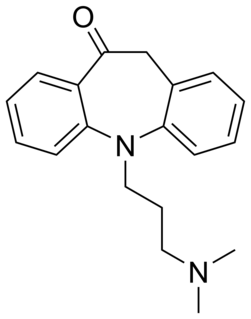
Ketipramine (G-35,259), also known as ketimipramine or ketoimipramine, is a tricyclic antidepressant (TCA) that was tested in clinical trials for the treatment of depression in the 1960s but was never marketed. It differs from imipramine in terms of chemical structure only by the addition of a ketone group, to the azepine ring, and is approximately equivalent in effectiveness as an antidepressant in comparison.
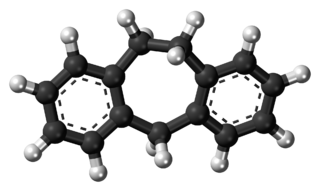
Preferably called dibenzosuberane is a tricyclic chemical compound featuring two benzene rings bound to a cycloheptene group. It is an occasional motif in synthetic organic chemistry. Various tricyclic antidepressants (TCAs) contain the dibenzocycloheptene moiety in their chemical structures, including amineptine, amitriptyline, amitriptylinoxide, butriptyline, demexiptiline, nortriptyline, noxiptiline, and protriptyline. Cyclobenzaprine, a skeletal muscle relaxant, also contains this functional group.

Mezepine is a tricyclic antidepressant (TCA) that was never marketed.

Enprazepine is a tricyclic antidepressant (TCA) which was never marketed.
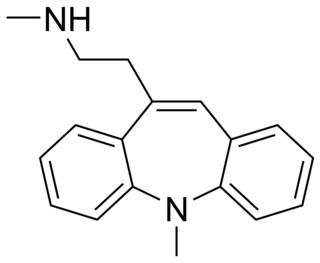
Amezepine is a tricyclic antidepressant (TCA) which was never marketed.

Dibenzoxepin, or dibenz[b,e]oxepin, is a tricyclic compound. It is the parent structure of certain drugs such as the tricyclic antidepressant doxepin and the analgesic fluradoline. The former is the only tricyclic antidepressant that is a dibenzoxepin.

Chloracyzine is an antidepressant and coronary vasodilator of the phenothiazine class, invented in Russia and used as an anti-anginal agent. It was found not to have antipsychotic activity, but was instead the first Russian tricyclic drug with antidepressant action.
